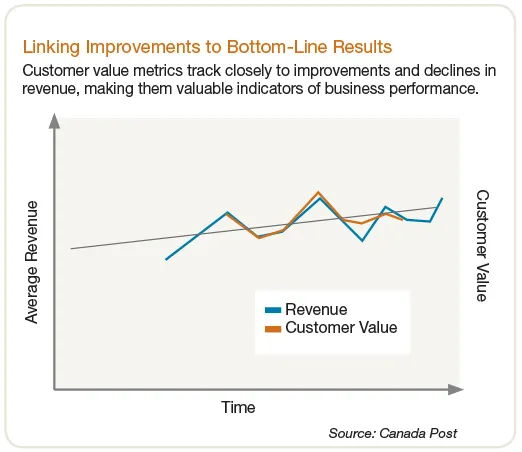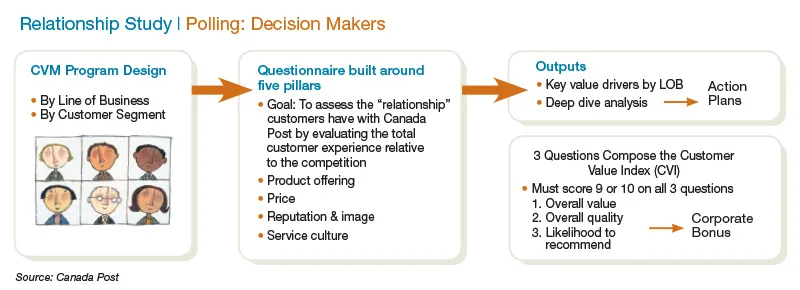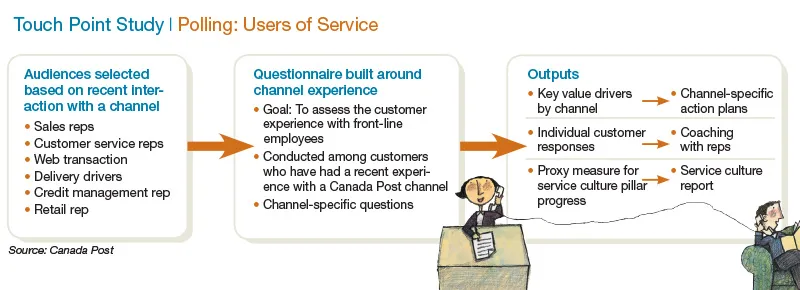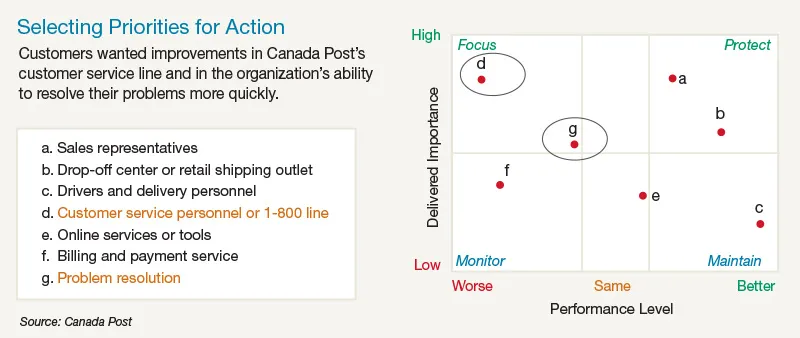Despite its size and market share, Canada Post is continuously evolving to meet customers’ needs. Since it was founded in 1867, Canada Post has a long and rich history in customer experience management as the country’s primary postal operator. The Crown Corporation (a designation for a state-owned enterprise), which is based in Ottawa, processes and delivers more than 10 billion letters and packages annually to 32 million Canadians and more than one million businesses and public institutions.
Our top corporate goals are tied to growth, modernizing operations, and improving the customer experience. We’ve taken several steps to help enhance the latter. These include creating an executive council, appointing customer experience specialists, and launching a comprehensive feedback strategy integrated with our customer value management program.
The executive council, launched in mid-2009, is comprised of our top executives from across the organization. Called the Customer Experience Council, it provides guidance on strategy for our six channels and our three primary lines of business: transaction mail, parcels, and direct marketing and publishing. It’s charged with examining the ideals we’re targeting for the ultimate customer experiences and the barriers we face in achieving those goals, identifying those players in the industry that have attained best practices status, and determining the steps we need to take to reach our objectives.
One of the most important steps that Canada Post has taken with respect to customer experience management occurred in 2007. We made a strategic decision to hire and invest in a team of specialists for each of our lines of business. The goal was to bring a higher level of expertise to the role than that of an account executive or a sales rep. We wanted people who had in-depth experience in our top customers’ industries, associates who could provide each customer with a stronger and richer one-to-one relationship. Our aim was to augment those relationships with an eye toward enhancing our revenue streams, and to identify and develop customized solutions for those customers.
We now have approximately 25 customer experience specialists who are devoted to our two most competitive product areas: parcels and direct marketing. Our transaction mail business currently represents about 55 percent of our total business. Canada Post’s direct marketing and publishing unit generates 23 percent of our overall revenues, while our parcels business comprises the other 22 percent of our sales.
Information influences action
For transaction mail, our account executives have frequent customer consultations and discussions around industry trends. These allow our transaction mail customers to provide input into our business and help them feel like partners, which they are. For example, we established an advisory panel with our transaction mail customers to help identify potential problem areas when Canada Post planned changes. The outcome of these panels and other collaboration activities was an increase in the perception that Canada Post was easy to use and applied its mail specifications consistently across the country.
Our transaction mail business is complex, with regular upgrades to mailing specifications. We needed to refocus our current sales force to provide personal and individual notification of product changes by providing preferential treatment to our large-volume mailers. Transaction mail customers who received preferential treatment had consistently higher loyalty scores than those who did not.
Another way our specialists connect with customers is via social media—including the use of blogs, wikis, Web forums, and social networking sites such as Facebook and LinkedIn. Customers seek our advice on how to integrate the social media sources they use as a component of their direct marketing strategies. As part of this, they need us to know about their industry and their businesses to help them stay on top of market shifts and other trends.
The customer experience management approach that we apply for clients in our parcels and direct marketing and publishing businesses is slightly different. We needed to bring in specialists who had a level of expertise (and years of practical experience) within our key customers’ industries and who understand the drivers and trends that are impacting each of those industries. We wanted to see whether these specialists could develop stronger one-to-one relationships with our customers and potentially drive additional revenue through the creation of supplementary customized solutions.
Each of Canada Post’s account executives and specialists receive training on an annual basis. This includes a series of webinars for account executives that covers all facets of direct marketing and direct mail.
Additionally, to help keep our specialists fluent on changing industry dynamics, they frequently attend sector-specific conferences. We find that they’re able to draw valuable insights from these events. One of the biggest benefits is their ability to network with peers and discuss the direct marketing challenges that other organizations may be facing. In turn, our specialists are able to incorporate these insights into their interactions with Canada Post’s customers.
Measuring the customer experience
Customers’ interactions with our specialists are just one way we keep abreast of our customers’ needs and opinions. Another is our customer management value program, which allows Canada Post to measure the perception that our customers have of their end-to-end experiences with our company. The program, which applies to each line of business, helps us to understand what our customers think of our product offerings: How do we compare to the competition? What’s most important to you? What do you value most?

As part of the program, we look at how our delivery performance compares to our rivals, such as DHL, FedEx, and UPS, within and outside Canada. We evaluate the percentage of packages that are delivered intact, and whether our prices are competitive.
One of the ways we gather this type of feedback from our customers is through a questionnaire that’s based on our five pillars of customer experience. The five categories we examine are product offering, product delivery, price, service culture, and reputation and image.
We ask questions that allow us to continually evaluate customers’ perception of our service culture: Do we respond quickly? Do we think about our customers before we make changes to our product offerings? Do we live up to our promises? The questionnaire audience is selected based on recent interactions they’ve had with one of our channels, including our sales reps, delivery drivers, credit management reps, or following a Web-based transaction.

Each of these interactions is critical to us. For instance, having letter carriers delivering to every single house every day throughout Canada is a huge competitive advantage. It reminds customers just how important Canada Post is as a Canadian institution.
The final pillar relates to our reputation and image. What is the overall perception of Canada Post to our customers? Do they think we’re a well-run business? Are we perceived as being socially responsible? Do we value efficiency? Do we take care of our employees? We want to know if our reputation is improving. With our 150-year history, we want to be viewed as a leader in shipping, communications, and marketing.

We then apply customer responses to a scorecard we refer to internally as our Customer Value Index. It’s what we consider to be our proxy for the percentage of customers we consider loyal to our businesses. We link these results to other operational and financial measures. For instance, we’ll gauge the percentage of customers who are viewed as being loyal to Canada Post and try to determine from the results the types of value propositions we need to offer to customers to encourage them to stay with us.
Not only do we look at the Customer Value Index in terms of the health of the three businesses from a very strategic level, but also from an operational perspective. As such, we do extensive linkage analysis between customer value and problem resolution, on-time delivery, and the like.
Customer-guided experiences
We also apply other inputs to measure customer experience. We have two different tracks within the customer value measurement program that have been in place since 2004. The first one is our relationship study, where we ask customers who are key decision makers about their relationship with Canada Post. We ask them to evaluate their end-to-end experience and also to assess their relationship with the company. We use results from the relationship study to guide strategic decisions: Where should we invest our money? What do customers value most?
The other module is our transactional program. This relates to a customer’s most recent transaction with one of our channels. If they received an email or a package, we ask customers to help us evaluate the specific transaction they experienced. Were our front-line associates helpful? Were they knowledgeable?

This feedback helps us to determine areas for improvement. For example, following the implementation of a training program to increase knowledge, we would use our customer measurement program to determine whether there was an increase in the perceptions of customers regarding the knowledge of our front-line employees.
Our customer feedback mechanisms have helped us to generate other operational improvements. For example, within claims processing, we’ve incorporated customer feedback to revise our policies and associate scripts. Based on our customers’ recommendations, we’ve also empowered associates to pay claims at the first point of contact. These and other process improvements have led customers to report a 17 percent increase in the quality of our claims processing over the past six months. In addition, customer claims are now being processed 25 percent faster and claims cases resolved on the first call have increased by 50 percent.
We also link the customer experience to employee performance through our performance management system. At Canada Post, from our CEO to our front-line, employees are accountable to improve the customer experience where they have control or can influence change. For example, if our products don’t have the right features or our prices are not competitive, we can’t expect our sales reps to be accountable for these areas over which they have no control. To ensure that everyone is playing their role in improving the customer experience, we assign a customer value metric to performance scorecards throughout the organization related specifically to each job or area of expertise. We know that if everyone across the organization works hard to improve the customer experience as it relates to their area of expertise, the overall customer experience will improve and customer loyalty will increase.
Within our parcels business, we’ve been able to increase the percentage of loyal customers by 10 percentage points, which places them in the best-in-class range in terms of loyalty. These loyalty improvements have translated into millions of dollars in increased revenues on an annualized basis.















